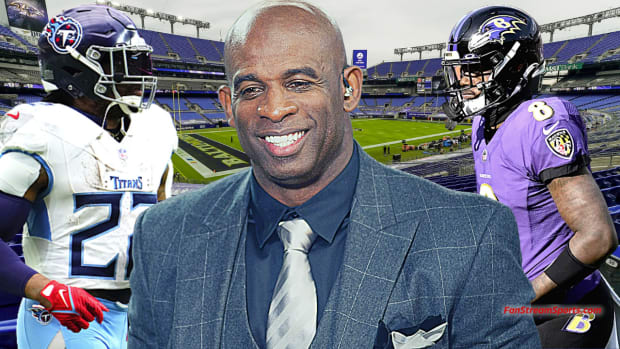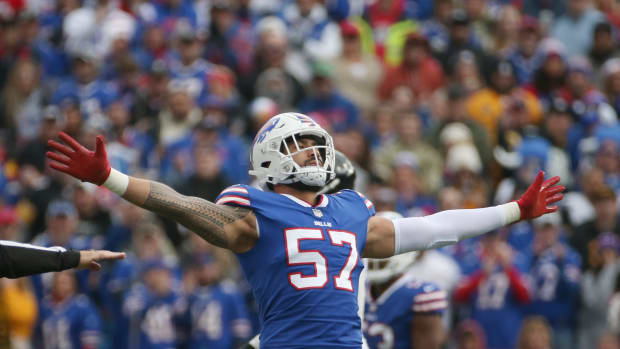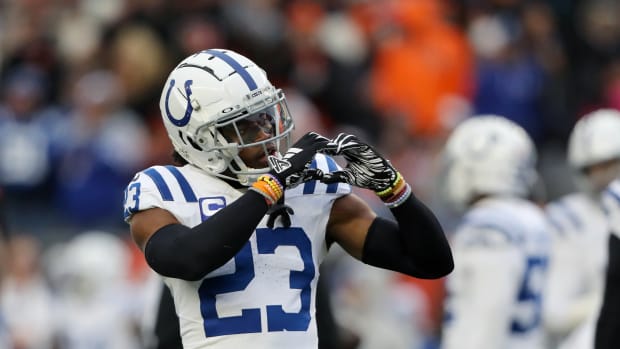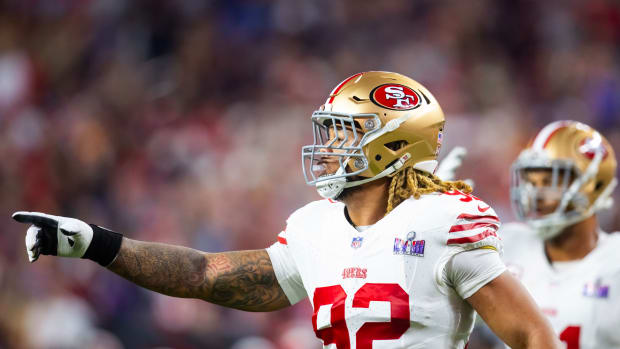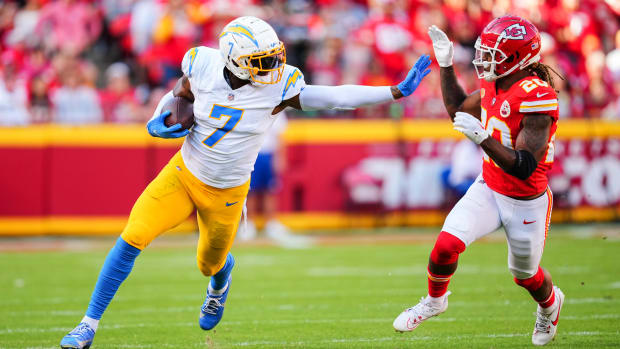
Projecting the NFL Draft: NFC North
How NFC North teams will approach in the NFL draft
Bears’ Problems
By Andy Benoit
With no change at quarterback on the horizon, new Bears GM Ryan Pace and head coach John Fox must figure out what type of supporting cast will best emphasize Jay Cutler’s strengths and minimize his weaknesses.
Conceptually, building around Matt Forte, rather than Alshon Jeffery, could be the answer. Forte can provide a sustained ground game, and he’s a phenomenal short-area receiver. This offensive approach engenders safer decision-making and patience from a quarterback. In this case, a backup for Forte must be considered. The Bears drafted Ka’Deem Carey in the fourth-round last year, and maybe the new regime will be comfortable using him regularly in a complementary role. But it’s an exceptionally deep draft for running backs; chances are Pace and Fox will encounter more talented options multiple times over the three-day selection process.
The other position to consider is tight end. A versatile No. 2 alongside Martellus Bennett would allow the Bears to play more in base personnel, which would mean facing more base defensive packages and thus looks and coverages that are predictable. But does tight end take priority over wide receiver? The position was disconcertingly thin even before Brandon Marshall was traded to the Jets.
Of course, none of the aforementioned areas supersede the needs on defense. First-year coordinator Vic Fangio, formerly of the Niners, wants to run a 3-4. With the Bears having been the most iconic 4-3 defense of the 2000s (and before), Fangio inherits a roster bereft of the types of front seven players to fit his scheme. Changes at outside linebacker are mandatory. Most likely, there will need to be alterations along the defensive line—though expect last year’s early-round picks, Ego Ferguson (second round) and Will Sutton (third), to get a long look. More important is inside linebacker. Fangio, having coached the ultra-physical and ultra-intelligent likes of Patrick Willis, NaVorro Bowman and Chris Borland, will not be fond of incumbent inside backers Jon Bostic and Khaseem Greene.
More NFL Draft Projections
AFC East ... AFC North ... AFC South ... AFC West
Bears’ Solutions
By Andy Staples
A team switching to a 3-4 should build around a nosetackle. At No. 7, the Bears should be able to grab the player who occasionally commanded triple-teams in college. Washington’s Danny Shelton, all 339 pounds of him, looks like the best 3-4 anchor in this draft. If you’re building a 3-4 and Shelton is available, you take him.
In a running back group this deep, a backup for Forte can wait. Next, the Bears can look for a linebacker to play behind Shelton. There will be a plethora of options in the second round, including UCLA’s Eric Kendricks, Mississippi State’s Benardrick McKinney, Clemson’s Stephone Anthony and TCU’s Paul Dawson. Each of these guys had a stellar college career, but Anthony brings the best combination of speed and size. Now let’s find that tailback. USC’s Buck Allen should be available in the third round and might even be available in the fourth. Allen is a low-mileage back with superior cutting ability. South Carolina’s Mike Davis also should be available in the third and could be available in the fourth. When healthy and engaged, Davis is an extremely versatile back who can exploit cutback lanes or achieve another gear to outrun tacklers.
Lions’ Problems
By Andy Benoit
The only semblance of offensive “needs” are at wide receiver, where depth is lacking, and along the front line, where more talent could be helpful at guard and right tackle. These needs aren’t mandatory, however. Unless there’s an absolute steal left on the board, GM Martin Mayhew should focus his efforts on defense.
The addition of Haloti Ngata fills just a portion of the hole left by the losses of Ndamukong Suh and Nick Fairley. Ngata can still play; the Ravens only traded him because young backup defensive tackles Timmy Jernigan and Brandon Williams are high-end starters in waiting. But at 31, the light-footed, 340-pound Ngata does not flash as regularly as he once did. And there have to be concerns about his body’s ability to rebound from naturally occurring maladies; he has struggled at times playing through injuries in recent years. What’s more, there are no other proven defensive tackles on Detroit’s roster.
The Lions’ M.O. has been to generate pressure with a four-man rush and play coverage behind it. But with only one bona fide pass rusher on the roster (budding star Ziggy Ansah) and second-year defensive coordinator Teryl Austin familiar with a Ravens-style scheme, they could fully transform into a pressure-based defense in 2015 and beyond. Which means they’d need more range at safety. Glover Quin is adequate but better near the box; ditto and double that for James Ihedigbo. They’d also need more man-to-man corners. Some in the organization felt that the team got away with one last year having the likes of Rashean Mathis and Darius Slay play as much man coverage outside as they did. Mathis was recently re-signed, but a younger, more athletic player would ideally start opposite Slay. Consideration must also be taken for the nickel slot, easily Detroit’s weakest position a year ago.
More NFL Draft Projections
AFC East ... AFC North ... AFC South ... AFC West
Lions’ Solutions
By Andy Staples
The admission by Randy Gregory that he failed a drug test at the combine—which is essentially the equivalent of failing an intelligence test—leaves teams such as the Lions (pick No. 23) hoping for a Warren Sapp situation. There’s no guarantee that a positive marijuana test would cause Gregory to drop so far, but if he’s there, his pass rushing gifts make him worth the risk. If not, the Lions might be able to pick up Kentucky’s Bud Dupree or UCLA’s Owa Odighizuwa to rush the passer. Or they could opt for a defensive tackle in the first round. If they do, Florida State’s Eddie Goldman is a 6-4, 336-pounder who can play as a nose, a one-technique or a three-technique.
If the Lions opt for an end in the first, a quality defensive lineman in the 300-pound range to play alongside Ngata might be available in the second round (Ohio State’s Michael Bennett) or third round (Clemson’s Grady Jarrett). Both are quick, explosive linemen who do excellent work with their hands and keep their linebackers clean. Later, the Lions can pick up a free safety. Michigan State’s Kurtis Drummond, who should be quite familiar to the fan base, could be a steal in the fourth or fifth round. Or maybe the Lions want another corner or a nickel in that spot. Oregon’s Ifo Ekpre-Olomu, who tore his ACL in January, could be a bargain for the team willing to wait out his rehab.
Packers’ Problems
By Andy Benoit
It wasn’t surprising that Packers GM Ted Thompson allowed 32-year-old cornerback Tramon Williams (Browns) to leave in free agency. It was surprising that he allowed 25-year-old Davon House (Jaguars) to leave. Green Bay plays a lot of man coverage at corner, mixed with zone coverage at linebacker and safety. They’ve always had the exact types of personnel to make this work. That may no longer be true. Casey Hayward is an excellent slot man, but does he have the body structure and movement styles to play the perimeter opposite Sam Shields, with Micah Hyde handling the slot? This isn’t the worst scenario, but it’s an unproven one. To hedge this bet and bolster depth, Thompson should draft a corner early.
Depth along the defensive line is also suspect. Thompson’s history suggests this won’t be the case coming out of the draft. In fact, that history says he’ll take a defensive lineman in Round 1 or 2. He can afford to because, offensively, there’s nothing that needs to be addressed. The re-signing of right tackle Bryan Bulaga keeps the front five intact. Last year’s early round selections of wideout Davante Adams and tight end Richard Rodgers keep the passing game lavished with weapons. And a backfield featuring Eddie Lacy ensures that the league’s best quarterback has a running game to lean on.
More NFL Draft Projections
AFC East ... AFC North ... AFC South ... AFC West
Packers’ Solutions
By Andy Staples
If Florida State’s Goldman is around at No. 30, the Packers should grab him because they aren’t going to find a more versatile defensive lineman at that spot. If Goldman is gone, Oklahoma’s Jordan Phillips is another large man (6-5, 329) who plays like a smaller, quicker man.
Washington cornerback Marcus Peters could be another possibility at No. 30, if he drops to this point because of the issues that got him thrown off the team in Seattle last season. Peters might be the most physically well-rounded cornerback in the draft, and if he’s still available here, he might be worth the risk. If the Packers address the defensive line early, then they might be able to pick up standing broad jump world-record holder (and former Connecticut cornerback) Byron Jones. Jones is a 6-1 former safety with raw athleticism. Playing on a terrible team kept him out of the spotlight, but NFL teams have certainly noticed him.
Since the Packers are so stacked and can afford to draft for depth, they might consider using a third-round pick to reunite T.J. Yeldon with former Alabama backfieldmate Eddie Lacy. The pair made for an excellent one-two punch on Alabama’s 2012 national title team. Maybe they could do it again.
Vikings’ Problems
By Andy Benoit
If Adrian Peterson doesn’t play for Minnesota again, running back becomes a priority, but not necessarily a top one. Jerick McKinnon has the quickness and fluidity to be a quality NFL starter. The question is whether he can stay healthy and carry a full load. If the Vikings are skeptical, they’ll likely draft a complementary piece in the middle rounds. Before that, however, they need to improve the offensive line. Right guard Brandon Fusco, who missed all but three games with a torn pec last year, made strides in 2013. On the left side, 2014 fifth-rounder David Yankey is slated to start. It would be prudent to add a third man who could push either guy. A more interesting decision must be made at left tackle. In his rookie 2012 campaign, Matt Kalil showed why he was drafted fourth overall. But in 2013, Kalil struggled. And in 2014, he was outright horrible until late in the year. The Vikings will have to decide whether to pick up his fifth-year option after this season. But they could decide to draft a replacement—or at least someone to push him.
Defensively, the landscape is very encouraging. The front line needs no major upgrades after the re-signing of backup Tom Johnson, who can operate inside or outside. The linebacker position is thin and could use attention down the road. But with Chad Greenway and his $7 million salary still on the roster, there’s nothing that needs to be immediately addressed. In the secondary, safety Robert Blanton is very so-so. He could be replaced. The rest of the group is solid if not spectacular, with Xavier Rhodes on the cusp of becoming a true No. 1 corner and Harrison Smith being a top five all-around safety.
More NFL Draft Projections
AFC East ... AFC North ... AFC South ... AFC West
Vikings’ Solutions
By Andy Staples
If the Vikings want some options on the offensive line, they should have a chance at No. 11 to take a college left tackle who probably could play tackle or guard in the NFL. How’s that for options? Meanwhile, former Iowa tackle—and former 295-pound high school quarterback—Brandon Scherff probably would be thrilled to play less than five hours from his hometown of Denison, Iowa.
The Vikings could pick up a linebacker in the second round. We already discussed the quality of the inside linebacker group in this part of the draft in the Bears section, and at least one of those guys will be available when the Vikings draft in the second. On the outside, Washington’s Shaq Thompson could be gone by No. 45, but if he’s still hanging around, they should pick him up. Thompson can play sideline-to-sideline. He can rush the passer. He can cover. His combine 40 time (4.64) might scare some NFL teams, but it shouldn’t. He runs just fine in pads. Plus, his experience moonlighting as a tailback at Washington makes him even more valuable.
Later, the Vikings can add backfield depth. South Carolina’s Davis, USC’s Allen and Auburn’s Cameron Artis-Payne all bring elite traits with lingering question marks, but any of the above would be worth the risk if he’s still hanging around in the fourth round.
Follow The MMQB on Facebook, Twitter and Instagram.
[widget widget_name="SI Newsletter Widget”]










































